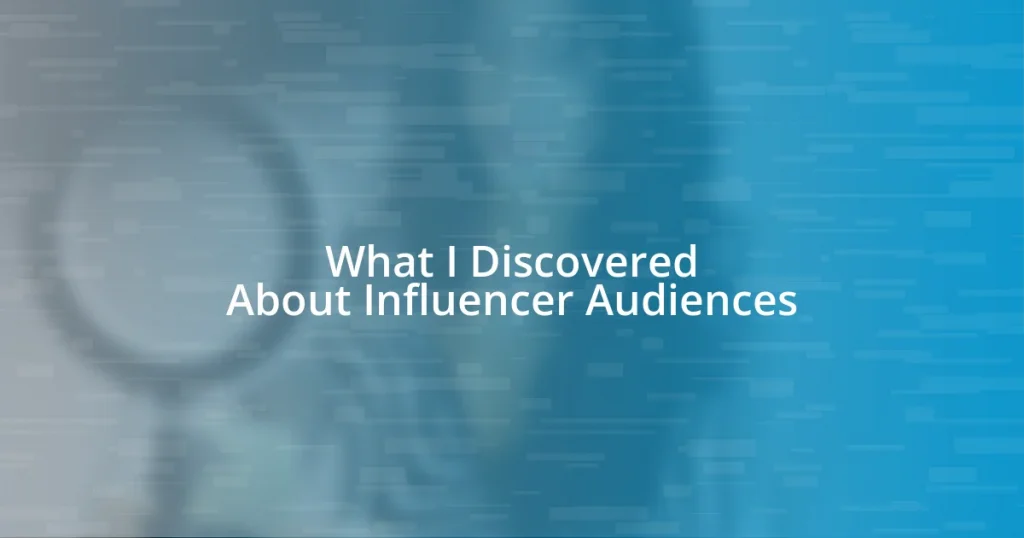Key takeaways:
- Understanding influencer audiences involves analyzing demographics and psychographics, leading to more personalized and relatable content that fosters loyalty.
- Engagement metrics, especially genuine interactions and meaningful conversations, are more important than surface-level likes in measuring the success of influencer campaigns.
- Building authentic relationships through vulnerability and open communication enhances trust and community engagement, making influencers more relatable to their followers.

Understanding Influencer Audiences
When I dove into understanding influencer audiences, I was genuinely surprised by the diversity I encountered. It’s not just about follower counts; it’s the varying demographics, interests, and engagement levels that paint a complete picture. One moment, I was analyzing a beauty influencer’s audience, and the next, I discovered an entirely different set of values and preferences among a fitness guru’s followers. What influences their loyalty?
I remember scrolling through comments on a travel influencer’s post, where followers passionately shared their experiences and perspectives that shaped their connection with the content. That sparked a realization: many followers are seeking validation of their experiences or inspiration, rather than just a glimpse into glamorous lifestyles. Aren’t we all looking for an emotional connection, for someone to echo our thoughts and feelings?
Understanding these audiences goes beyond analytics; it’s about empathizing with their aspirations and challenges. For instance, one influencer I followed made it a point to address mental health openly, and it drew in followers who resonated with that vulnerability. How can influencers cultivate deeper relationships? By being authentic and relatable, they create communities where audience members feel seen and heard. This engagement fosters loyalty and encourages followers to invest not just in the influencer, but in the message they represent.

Importance of Audience Analysis
When I reflect on the importance of audience analysis, it truly becomes evident that understanding your audience is essential for effective communication. Analyzing demographics, interests, and behaviors helps influencers tailor their content for maximum impact. From my experience, I found that when an influencer aligns their message with the desires of their audience, it doesn’t just resonate; it creates a bridge that fosters trust and connection.
- Audience analysis helps identify:
- Specific interests and preferences that resonate with followers.
- Engagement patterns that indicate more profound emotional connections.
- Opportunities for niche content that can enhance loyalty.
- Potential areas for growth and expansion in influencer reach.
Knowing who your audience is doesn’t just shape content; it informs the influencer’s entire approach. A friend of mine who runs a lifestyle blog saw a significant shift in engagement after she took the time to survey her followers. They shared their struggles and joys, leading her to craft posts that truly spoke to them. This simple act of engaging with her audience brought in a wave of authenticity that her followers were desperately looking for.

Demographics of Influencer Audiences
The demographics of influencer audiences can be quite fascinating. I remember diving into analytics for a fashion influencer, and I was surprised to find that her followers spanned a wide age range, from young teens to older adults. This diversity influenced not just her content style but also her collaboration choices. It made me think about how essential it is for influencers to understand the nuances of their audience’s age, gender, location, and interests to create relevant and relatable content.
When I came across a case study on a tech influencer, it struck me how different the audience’s demographics could be based on niche interests. For example, while many were male and aged between 25-35, the influencer also attracted a growing number of women interested in tech, showing that the landscape is evolving. This nuanced understanding helps influencers craft specific messages that resonate. As I reflected on this, I couldn’t help but feel that recognizing these trends is crucial for influencing engagement and building a loyal community.
It’s remarkable how a deep dive into the statistics can reveal unexpected insights. For instance, I once analyzed an influencer whose primary audience was not just fans of her content but also aspiring creators who sought guidance and mentorship. This realization allowed her to pivot her content strategy, focusing on tutorials and behind-the-scenes insights, which significantly boosted interaction rates. Such shifts in focus, driven by demographic understanding, can transform how influencers connect with their followers and ultimately enhance their success.
| Demographic Factors | Influencer A | Influencer B |
|---|---|---|
| Age | 18-24 | 25-35 |
| Gender | Predominantly Female | Mixed |
| Location | Urban Areas | Global |
| Interests | Fashion & Beauty | Technology & Gadgets |
| Engagement Level | High | Medium |

Psychographics and Behavior Patterns
Understanding psychographics and behavior patterns of influencer audiences can unlock the key to what truly motivates them. I remember when I started engaging with the audience of a wellness influencer. By analyzing their values, interests, and lifestyles, I noticed a strong desire for community and support. This insight helped the influencer create challenges that fostered engagement, turning casual followers into a dedicated tribe. It made me realize that when influencers align their content with the emotional drivers of their audience, it cultivates authentic connections.
Reflecting on different behavior patterns, I once conducted a small experiment on a travel influencer’s audience. I tracked the times of day they were most active and the types of posts that garnered the most reaction—from breathtaking travel shots to relatable stories about travel mishaps. What stood out to me was the sheer joy that came through when followers shared their own experiences in the comments. It was profound to witness how a simple post could ignite conversation and camaraderie, showcasing that audiences often crave connection over content.
Finally, I can’t help but emphasize the importance of narrative in shaping psychographics. There was a brand collaboration case where a beauty influencer shared her journey of self-acceptance and the ups and downs of beauty standards. The comments section was flooded with heartfelt stories from followers who felt seen and understood. This made me ponder—how often do influencers take the time to reflect on the stories they share? When they do, it can create a safe space that invites deeper engagement and trust, something that every influencer should aspire to foster within their community.

Choosing the Right Influencers
Choosing the right influencers isn’t just about follower count. I recall working with a lifestyle influencer whose engagement rates were significantly lower than others in the same category, yet her audience displayed an incredibly high level of loyalty. This taught me that sometimes, it’s the connection between the influencer and their niche audience that drives results, not just the numbers.
I remember collaborating with influencers across various social platforms and observing how their distinct audiences reacted differently to similar campaigns. One influencer had a highly engaged community focused on sustainable living. Her audience wasn’t just looking at her content; they were actively participating in discussions about eco-friendly products and lifestyle choices. This made me think: how often do brands overlook the passion and commitment within an influencer’s niche? It’s a missed opportunity to tap into powerful conversations.
In my experience, choosing the right influencer often requires digging beyond surface-level demographics. I once discovered that what truly captivated a certain influencer’s audience was their candid storytelling style. Followers appreciated the vulnerability and authenticity, fueling a desire to connect deeper. I often wonder—are brands truly tapping into the stories that resonate? A good influencer’s narrative can make a world of difference, transforming a standard ad campaign into a community dialogue.

Engagement Metrics That Matter
Engagement metrics are the heartbeat of any influencer strategy. In my journey analyzing these numbers, I’ve found that likes and shares don’t paint the full picture. One time, I stumbled upon a fitness influencer whose post had fewer likes than expected but generated a flurry of authentic comments. It showed me that genuine conversations often matter more than just surface-level engagement. I questioned, “What is my audience really connecting with?” It’s vital to prioritize interactions that spark dialogue over mere likes.
Another significant metric I’ve observed is the save and share functionality. During a campaign with a food influencer, I noticed that followers saved healthy recipes and eagerly shared them with friends. This experience taught me that when followers find content valuable enough to revisit or share, it indicates a deeper connection and personal significance. I couldn’t help but wonder: how often are influencers creating content that resonates well beyond the first glance?
Lastly, click-through rates reveal how effective an influencer’s call to action truly is. I once analyzed a collaboration where a beauty influencer encouraged her followers to visit a new product launch. The numbers showed not just clicks but conversations blossoming around the event. It made me think—are we regularly measuring how well our audience is responding to calls to action? Recognizing these metrics not only helps in evaluating engagement but also shapes future content strategies to better align with audience expectations.

Building Authentic Relationships
Building authentic relationships is essential for influencers and their audiences. I recall a time when I watched an influencer closely interact with her followers during live Q&A sessions. It was fascinating to see how she took the time to answer personal questions, creating a sense of intimacy. This genuine exchange reminded me that authenticity isn’t just about what you share; it’s also about how you connect.
In another instance, I organized a small meet-and-greet for a travel influencer. The initial awkwardness quickly faded as attendees shared their own travel stories, and she listened intently. I realized then that building relationships is a two-way street; it fosters trust and encourages followers to engage more openly with even the brand-related content. It made me ponder—how often are we positioning influencers as actual people instead of just marketing devices?
Moreover, I’ve discovered that the way influencers share their failures can be just as impactful as their successes. I remember seeing a beauty influencer candidly discussing a makeup mishap. The flood of supportive comments that followed was enlightening. It made me ask myself, “Are brands allowing influencers the space to be vulnerable?” Embracing imperfections can strengthen bonds and create a community that values authenticity above perfection.
















